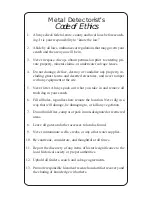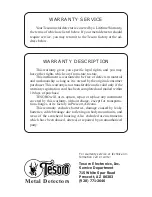
The SENSITIVITY knob is numbered from MIN to 10 and then has an
orange area called the Max Boost Zone. For normal hunting, anywhere in
the numbered zone will work very well. However, the Max Boost will al-
low you to increase the power to the operational amplifiers to the point of
overload. This may cause your detector to become unstable and force you
to turn the SENSITIVITY knob to a lower setting. An overload situation
will not hurt your detector, but it will maximize the gain that is used by
your detector. This can, in certain conditions such as low mineralization in
the soil, cause your detector to penetrate deeper into the ground and be-
come more sensitive to small targets.
Take some time to try waving targets in front of the coil with different
sensitivity settings. Notice that the higher the sensitivity setting, the farther
away from the coil that a target can be and still respond with an audio
signal.
Perform Air Test in DISC Mode
As discussed before, the discriminate mode is used to filter unwanted
targets from good targets. The principle behind this is pretty simple. The
detector sends out a signal and then receives it back creating a small elec-
tronic field. As metal passes through the field that the detector generates, it
causes a change in the received signal. The amount of change that each
type of metal causes is fairly constant; therefore, we can tune our detectors
to miss targets that we don’t want to find. The change is based on the type
of conductivity that each target has. The general list of conductive targets
is as follows: iron, foil, nickels, gold jewelry, pull tabs, screw tabs, pennies
and silver coins starting with dimes and working up to silver dollars. This list
is meant to be a guide only. There is a point that some pull tabs, nickels and














































